Effect of inorganic, organic in pigs
Effect of inorganic, organic, and no trace mineral supplementation on growth performance, fecal excretion, and apparent digestibility of grow-finish pigs
Published: August 27, 2007
By: J.L. Burkett, K.J. Stalder, W.J. Powers, T.J. Baas and B.L. Shafer (Iowa State University), James Pierce (Alltech, Inc) (Courtesy of Alltech Inc.)
With an increasing awareness of environmental contamination, trace minerals have come to the forefront for further research. Public concerns are mainly related to soil (accumulation and runoff of minerals from land where manure is applied), water (surface and ground water), and air quality issues (Stalder et al., 2004).
To date, pigs have been fed concentrate diets, formulated to provide a margin of excess trace minerals and other nutrients in order to maximize performance and to allow the pig to withstand various biological stress events (Carlson et al., 1999; Hill et al., 2000). Trace minerals exceeding animal requirements are excreted, which can lead to possible bioaccumulation in the soil and potentially threaten water sources due to runoff (Besser, 2001).
Currently, large-scale swine production systems have concentrated the volume of manure produced within a geographical area, which can lead to nutrient accumulations that exceed crop requirements. In order to handle this increasingly important environmental challenge, producers must look at two options. The first option is to examine ways to improve the efficiency of nutrient use, and the second is to more closely feed pigs to their physiological requirements for optimal growth, performance and health, thus reducing the potential environmental impact from excreta.
Organic trace mineral supplements have been introduced in livestock feeding, particularly in pig diets, because they may be more bioavailable to the animal. Pig diets are usually supplemented with trace minerals, including iron (Fe), zinc (Zn), copper (Cu), manganese (Mn), selenium (Se), and other necessary minerals. These minerals may be added as salts, but in recent years, organic forms have been used (Jondreville et al., 2002; Revy et al., 2003).
Wedekind et al. (1992) reported a greater bioavailability of organic minerals than of inorganic forms, leading to an increased interest in these products. Leeson (2003) reported that chelated trace minerals (e.g. Bioplex®) are at least 30% more bioavailable when compared to inorganic trace mineral salts when fed to broilers. Research conducted by Pierce et al. (2001) showed that pigs fed organic Cu (Bioplex®) had similar performance to those fed inorganic Cu; however, pigs receiving the organic Cu had a 46% decrease in fecal Cu concentration.
Experiments with grow-finish pigs
Two experiments were conducted at Iowa State University to evaluate the effects of differing concentrations of trace mineral supplementation (Cu, Fe, and Zn) on fecal mineral excretion and apparent digestibility of grow-finish pigs. Pigs fed diets containing reduced concentrations of organic Cu, Fe, and Zn (Bioplex®, Alltech Inc.) were compared to pigs fed diets supplemented with a commercially available inorganic trace mineral premix at or in excess of NRC recommendations for trace mineral supplementation.
METHODS
In both experiments, crossbred pigs (Expt. 1, Iowa State University Lauren Christian Farm, Atlantic, IA (n=528); Expt. 2, Wilson’s Prairie View Farms, Burlington, WI (n=560) were blocked by weight, penned by sex (9-12 pigs per pen, 12 replicates per treatment) and housed in totally slatted, environmentally controlled confinement facilities.
A four-phase grow-finish feeding program (ad libitum) was utilized for all pigs in each experiment according to the following regimen: Phase 1 (18 to 37 kg), Phase 2 (37 to 55 kg), Phase 3 (55 to 82 kg) and Phase 4 (82 to 118 kg). Each pig was provided 0.9 to 1.3 m2 of floor space in each pen. An anthelminthic (Ivermectin, Merial Inc., USA) was used in both experiments to treat pigs prior to initiation of the test period. Pigs that were unhealthy or injured during the experiments were removed from the test. The number of pigs removed and reason for removal was documented and utilized to make comparisons of treatment effects.
Dietary treatments
A complete basal diet (meal form) was formulated and different sources (organic vs. inorganic) and concentrations of Cu, Fe, and Zn were used to develop the experimental dietary treatments. In Expt. 1, the control diet (TRT 1) was supplemented with commercially recommended levels of Cu as CuSO4, Fe as FeSO4, and Zn (of which 25% was ZnO and 75% was ZnSO4) at concentrations of 85, 169, and 163 mg/kg, respectively. These concentrations of Cu, Fe, and Zn were 13.40, 1.74, and 1.75 times the NRC (1998) recommendations, respectively.
Treatment 2 (TRT 2) contained commercially recommended levels of Cu, Fe, and Zn from organic sources (Bioplex®) at concentrations of 19, 131, and 91 mg/kg, respectively. These concentrations of Cu, Fe, and Zn were 3.00, 1.36, and 0.97 times the NRC (1998) recommendations, respectively. Organic Cu, Fe, and Zn concentrations from TRT 2 were reduced by 25 and 50% for TRT 3 and TRT 4, respectively. In Expt. 2, TRT 5 contained 25% of the Cu, Fe, and Zn (inorganic sources) concentrations found in TRT 1. Treatment 6 (TRT 6) contained Cu, Fe, and Zn concentrations that were identical to TRT 4 from Expt. 1.
Treatment 7 (TRT 7) contained Cu, Fe, and Zn concentrations that were reduced by 75% from the levels found in TRT 2 of Expt. 1. Treatment 8 (TRT 8) contained no supplemental microminerals and served as a negative control for Expt. 2. Experimental trace mineral premixes were manufactured commercially. Analyses of Cu, Fe, and Zn concentration of all diets are presented in Table 1.
Measurements
Pigs were weighed and feed disappearance was recorded at two-week intervals to monitor growth performance and feed efficiency throughout the entire experiment. Pigs were removed from test by pen at a mean BW of 118 kg. A National Swine Improvement Federation-certified technician collected ultrasonic measurements of backfat thickness (BF10) and loin muscle area (LMA) at the 10th rib.
Measurements were collected with the use of an Aloka 500V ultrasound machine equipped with a 12.5 cm, 3.5 MHz linear array transducer (Corometrics Medical Systems, Inc., Wallingford, CT). Kilograms of lean (KL) at market weight and at trial entry were estimated using the fat-free lean equations developed by the National Pork Producers Council (NPPC, 2000).
Lean gain on test (LGOT) was calculated by subtracting the estimate of trial entry lean from market weight lean and dividing by days on test. Additionally, percent lean on a live basis (PLL) and on a carcass basis (PLC) were calculated from ultrasonic measurements using the NPPC formula (National Pork Producers Council, 2000). Pen feed intake was recorded and used to calculate average daily feed intake (ADFI), feed efficiency (FE), and efficiency of lean gain (LE). Efficiency of lean gain (LE) was calculated by dividing feed intake (pen basis) by weight gain on test (pen basis).
Table 1. Analyzed concentrations of Cu, Fe, and Zn supplemented in Experiments 1 and 2.
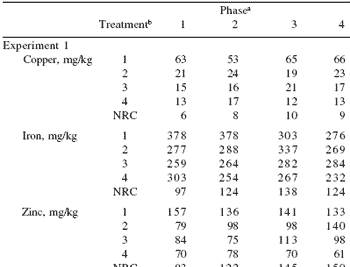
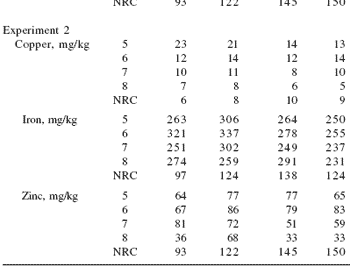
aPhase 1 - diet fed from 18-37 kg of BW; Phase 2 - diet fed from 37-55 kg of BW; Phase 3 - fed from 55-82
kg of BW; Phase 4 - diet fed from 82-118 kg of BW.
bTreatment 1 (control) - 100% from inorganic sources;
Treatment 2 – 100% from Bioplexes®;
Treatment 3 – 25% reduction from TRT 2;
Treatment 4 – 50% reduction from TRT 2;
Treatment 5 – 75% reduction of TRT 1 from inorganic sources;
Treatment 6 – 50% reduction of TRT 2 in Bioplex® form;
Treatment 7 – 25% reduction from TRT 6;
Treatment 8 – No Cu, Fe, Zn, and Se supplementation.
Fecal grab samples (approximately 100 g of DM) were collected from every pig in both experiments during each of the four growth phases. Fecal samples were dried in an oven at 55°C for 48 h. Diatomaceous earth was added to all diets at 0.01% as an indigestible marker.
The dried samples were pooled by pen and experiment on an equal weight basis and the pooled sample was stored for mineral analysis and evaluation of DM content. Feed samples were collected in order to analyze the diet consumed prior to fecal collection. Feed samples were ground to achieve a homogenous sample for analyses. Samples of all diets and fecal samples from both experiments were sent to Dairy One Inc. (Ithaca, NY) for trace mineral analysis and evaluation of DM content. All diet minerals were analyzed using a Thermo Jarrell Ash IRIS Advantage HX Inductively Coupled Plasma (ICP) Radial Spectrometer.
Dry matter of feed samples was evaluated by Near Infrared Reflectance Spectroscopy (NIRS) (AOAC 991.03), and fecal DM content was analyzed using AOAC procedures.
RESULTS
Performance
Average daily gain. No treatment differences for ADG (P>0.05) were found in Expt. 1 (Table 2). In Expt. 2, pigs fed no added trace minerals (TRT 8) had lower ADG (P<0.05) when compared to pigs fed the other three diets in the experiment. No differences in ADG (P>0.05) were observed among the three diets containing Cu, Fe, and Zn supplementation in Expt. 2.
Average daily feed intake. In Expt. 1, pigs fed the diet containing inorganic forms of Cu, Fe, and Zn (TRT 1) consumed less (P<0.05) feed per day when compared to pigs fed diets containing organic forms of the same microminerals. In Expt. 2, pigs fed TRT 8 (no supplemental microminerals) had lower ADFI (P<0.05) than pigs fed the other experimental diets. Pigs fed TRT 8 that showed signs of parakeratosis, listlessness, and weight loss were removed from the experiment (n=38). The number of pigs removed from test by treatment was not different for TRT 5 (n=1), TRT 6 (n=3), and TRT 7 (n=4), however, all three were different from TRT 8 (n=38) (P<0.01).
Carcass composition. In Expt. 1, there were no differences (P>0.05) among treatment means for LGOT, LE, G:F, KL, PLL, and PLC. Additionally, in Expt. 2, no differences among treatments means for KL, PLL, and PLC were observed. Pigs fed TRT 8 had the lowest (P<0.05) LGOT and the poorest LE and G:F. In both experiments, no treatment differences were observed for BF10 and LMA (P>0.05).
Fecal excretion and apparent digestibility
Least squares means for fecal mineral concentration and apparent digestibility for Cu, Fe, and Zn are presented in Tables 3, 4, and 5, respectively.
Copper. In Expt. 1, pigs fed TRT 1 (inorganic trace minerals) excreted significantly greater concentrations of fecal Cu (P<0.05) across all four collection phases. Pigs fed TRT 4 excreted less Cu (P<0.05) during the last two collection phases and overall when compared to the other three diets.
Apparent digestibility of Cu was greater (P<0.05) for the pigs fed diets containing the three experimental concentrations of organic trace minerals during collection phases 2, 4, and overall when compared to pigs fed the diet containing inorganic trace minerals. Negative apparent digestibility values were realized for pigs fed TRT 1 (control) for phases 1, 2, and 4 as well as for the overall apparent digestibility of Cu. Pigs fed TRT 2, 3, and 4 experienced greater (P<0.05) overall apparent digestibility when compared to TRT 1.
Table 2. Least squares means, on a pen basis, for performance and carcass traits in Experiments 1 and 2a.

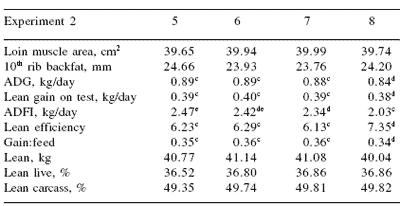
aMeans reflect only pigs that remained in the experiment for the entire test period.
bTreatment 1 (control) - 100% from inorganic sources;
Treatment 2 – 100% from Bioplexes®;
Treatment 3 – 25% reduction from TRT 2;
Treatment 4 – 50% reduction from TRT 2;
Treatment 5 – 75% reduction of TRT 1 from inorganic sources;
Treatment 6 – 50% reduction of TRT 2 in Bioplex® form;
Treatment 7 – 25% reduction from TRT 6;
Treatment 8 – No Cu, Fe, Zn, and Se supplementation.
cdeMeans with different superscripts within a row differ (P<0.05).
In Expt. 2, no differences among treatment means for fecal Cu excretion were observed by phase, however, pigs fed TRT 8 had the lowest concentration of fecal Cu over the entire test period (P<0.05) when compared to pigs fed diets containing supplemental trace minerals. Pigs fed TRT 5 (inorganic minerals) had greatest overall fecal Cu concentration for the trial. Apparent digestibility of Cu was the lowest and least favorable (P<0.05) for pigs fed TRT 5 (inorganic trace minerals).
Table 3. Least squares means for fecal Cu concentration (dry matter basis) and apparent digestibility (Cu) measured in Experiments 1 and 2.
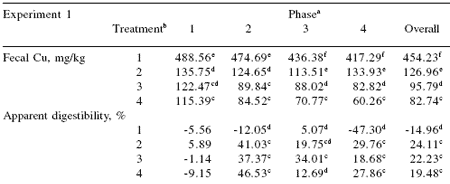

aPhase 1 - diet fed from 18-37 kg of BW; Phase 2 - diet fed from 37-55 kg of BW; Phase 3 - fed from 55-82 kg of BW; Phase 4 - diet fed from 82-118 kg of BW.
bTreatment 1 (control) - 100% from inorganic sources;
Treatment 2 – 100% from Bioplexes®;
Treatment 3 – 25% reduction from TRT 2;
Treatment 4 – 50% reduction from TRT 2;
Treatment 5 – 75% reduction of TRT 1 from inorganic sources;
Treatment 6 – 50% reduction of TRT 2 in Bioplex® form;
Treatment 7 – 25% reduction from TRT 6;
Treatment 8 – No Cu, Fe, Zn, and Se supplementation.
cdefLeast squares means with different superscripts within a column (phase) and trait differ (P<0.05).
Iron. In Expt. 1, pigs fed diets containing organic trace mineral supplementation had the lowest fecal Fe concentration (P<0.05) during phases 1, 2, 3, and overall when compared to pigs fed the control diet (TRT 1). Bioplex® organic trace mineral supplementation at 50% of commonly added trace mineral concentrations (TRT 4) appeared to be the most beneficial in lowering fecal Fe concentrations.
No differences among treatment means for fecal Fe concentration (P>0.05) were observed during collection phase 1 and overall in Expt. 2. Pigs receiving no trace mineral supplementation (TRT 8) had the lowest fecal Fe concentration during phase collection 3.
Zinc. In Expt. 1, pigs fed TRT 1 had higher fecal Zn concentrations (P<0.05) in all four collection phases (Table 5). Pigs fed TRT 4 during the grow-finish period had the lowest (P<0.05) fecal concentration of Zn over the entire test period. Pigs fed the diets containing Bioplex® trace minerals experienced greater apparent Zn digestibility during phases 2, 3, 4 and overall when compared to TRT 1. During the first collection phase, pigs fed TRT 2 had a negative apparent digestibility for Zn.
Table 4. Least squares means for fecal Fe concentration (dry matter basis) and apparent digestibility (Fe) measured in Experiments 1 and 2.
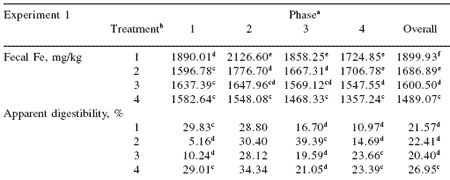
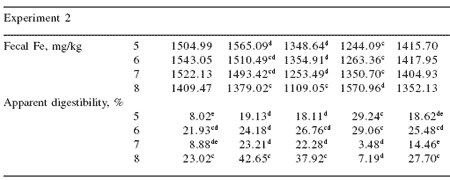
aPhase 1 - diet fed from 18-37 kg of BW; Phase 2 - diet fed from 37-55 kg of BW; Phase 3 - fed from 55-82 kg of BW; Phase 4 - diet fed from 82-118 kg of BW.
bTreatment 1 (control) - 100% from inorganic sources;
Treatment 2 – 100% from Bioplexes®;
Treatment 3 – 25% reduction from TRT 2;
Treatment 4 – 50% reduction from TRT 2;
Treatment 5 – 75% reduction of TRT 1 from inorganic sources;
Treatment 6 – 50% reduction of TRT 2 in Bioplex® form;
Treatment 7 – 25% reduction from TRT 6;
Treatment 8 – No Cu, Fe, Zn, and Se supplementation.
cdefLeast squares means with different superscripts within a column (phase) and trait differ (P<0.05).
Pigs fed TRT 6 in Expt. 2 had the highest fecal concentration (P<0.05) of Zn for the entire grow-finish period. Pigs fed no trace mineral supplementation (TRT 8) had the lowest (P<0.05) concentration of Zn in the feces, however, some pigs receiving this treatment displayed symptoms of parakeratosis and were removed from test upon diagnosis.
Table 5. Least squares means for fecal Zn concentration (dry matter basis) and apparent digestibility (Zn) measured in Experiments 1 and 2.

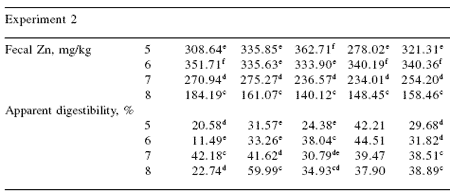
aPhase 1 - diet fed from 18-37 kg of BW; Phase 2 - diet fed from 37-55 kg of BW; Phase 3 - fed from 55-82 kg of BW; Phase 4 - diet fed from 82-118 kg of BW.
bTreatment 1 (control) - 100% from inorganic sources;
Treatment 2 – 100% from Bioplexes®;
Treatment 3 – 25% reduction from TRT 2;
Treatment 4 – 50% reduction from TRT 2;
Treatment 5 – 75% reduction of TRT 1 from inorganic sources;
Treatment 6 – 50% reduction of TRT 2 in Bioplex® form;
Treatment 7 – 25% reduction from TRT 6;
Treatment 8 – No Cu, Fe, Zn, and Se supplementation.
cdefLeast squares means with different superscripts within a column (phase) and trait differ (P<0.05).
To date, pigs have been fed concentrate diets, formulated to provide a margin of excess trace minerals and other nutrients in order to maximize performance and to allow the pig to withstand various biological stress events (Carlson et al., 1999; Hill et al., 2000). Trace minerals exceeding animal requirements are excreted, which can lead to possible bioaccumulation in the soil and potentially threaten water sources due to runoff (Besser, 2001).
Currently, large-scale swine production systems have concentrated the volume of manure produced within a geographical area, which can lead to nutrient accumulations that exceed crop requirements. In order to handle this increasingly important environmental challenge, producers must look at two options. The first option is to examine ways to improve the efficiency of nutrient use, and the second is to more closely feed pigs to their physiological requirements for optimal growth, performance and health, thus reducing the potential environmental impact from excreta.
Organic trace mineral supplements have been introduced in livestock feeding, particularly in pig diets, because they may be more bioavailable to the animal. Pig diets are usually supplemented with trace minerals, including iron (Fe), zinc (Zn), copper (Cu), manganese (Mn), selenium (Se), and other necessary minerals. These minerals may be added as salts, but in recent years, organic forms have been used (Jondreville et al., 2002; Revy et al., 2003).
Wedekind et al. (1992) reported a greater bioavailability of organic minerals than of inorganic forms, leading to an increased interest in these products. Leeson (2003) reported that chelated trace minerals (e.g. Bioplex®) are at least 30% more bioavailable when compared to inorganic trace mineral salts when fed to broilers. Research conducted by Pierce et al. (2001) showed that pigs fed organic Cu (Bioplex®) had similar performance to those fed inorganic Cu; however, pigs receiving the organic Cu had a 46% decrease in fecal Cu concentration.
Experiments with grow-finish pigs
Two experiments were conducted at Iowa State University to evaluate the effects of differing concentrations of trace mineral supplementation (Cu, Fe, and Zn) on fecal mineral excretion and apparent digestibility of grow-finish pigs. Pigs fed diets containing reduced concentrations of organic Cu, Fe, and Zn (Bioplex®, Alltech Inc.) were compared to pigs fed diets supplemented with a commercially available inorganic trace mineral premix at or in excess of NRC recommendations for trace mineral supplementation.
METHODS
In both experiments, crossbred pigs (Expt. 1, Iowa State University Lauren Christian Farm, Atlantic, IA (n=528); Expt. 2, Wilson’s Prairie View Farms, Burlington, WI (n=560) were blocked by weight, penned by sex (9-12 pigs per pen, 12 replicates per treatment) and housed in totally slatted, environmentally controlled confinement facilities.
A four-phase grow-finish feeding program (ad libitum) was utilized for all pigs in each experiment according to the following regimen: Phase 1 (18 to 37 kg), Phase 2 (37 to 55 kg), Phase 3 (55 to 82 kg) and Phase 4 (82 to 118 kg). Each pig was provided 0.9 to 1.3 m2 of floor space in each pen. An anthelminthic (Ivermectin, Merial Inc., USA) was used in both experiments to treat pigs prior to initiation of the test period. Pigs that were unhealthy or injured during the experiments were removed from the test. The number of pigs removed and reason for removal was documented and utilized to make comparisons of treatment effects.
Dietary treatments
A complete basal diet (meal form) was formulated and different sources (organic vs. inorganic) and concentrations of Cu, Fe, and Zn were used to develop the experimental dietary treatments. In Expt. 1, the control diet (TRT 1) was supplemented with commercially recommended levels of Cu as CuSO4, Fe as FeSO4, and Zn (of which 25% was ZnO and 75% was ZnSO4) at concentrations of 85, 169, and 163 mg/kg, respectively. These concentrations of Cu, Fe, and Zn were 13.40, 1.74, and 1.75 times the NRC (1998) recommendations, respectively.
Treatment 2 (TRT 2) contained commercially recommended levels of Cu, Fe, and Zn from organic sources (Bioplex®) at concentrations of 19, 131, and 91 mg/kg, respectively. These concentrations of Cu, Fe, and Zn were 3.00, 1.36, and 0.97 times the NRC (1998) recommendations, respectively. Organic Cu, Fe, and Zn concentrations from TRT 2 were reduced by 25 and 50% for TRT 3 and TRT 4, respectively. In Expt. 2, TRT 5 contained 25% of the Cu, Fe, and Zn (inorganic sources) concentrations found in TRT 1. Treatment 6 (TRT 6) contained Cu, Fe, and Zn concentrations that were identical to TRT 4 from Expt. 1.
Treatment 7 (TRT 7) contained Cu, Fe, and Zn concentrations that were reduced by 75% from the levels found in TRT 2 of Expt. 1. Treatment 8 (TRT 8) contained no supplemental microminerals and served as a negative control for Expt. 2. Experimental trace mineral premixes were manufactured commercially. Analyses of Cu, Fe, and Zn concentration of all diets are presented in Table 1.
Measurements
Pigs were weighed and feed disappearance was recorded at two-week intervals to monitor growth performance and feed efficiency throughout the entire experiment. Pigs were removed from test by pen at a mean BW of 118 kg. A National Swine Improvement Federation-certified technician collected ultrasonic measurements of backfat thickness (BF10) and loin muscle area (LMA) at the 10th rib.
Measurements were collected with the use of an Aloka 500V ultrasound machine equipped with a 12.5 cm, 3.5 MHz linear array transducer (Corometrics Medical Systems, Inc., Wallingford, CT). Kilograms of lean (KL) at market weight and at trial entry were estimated using the fat-free lean equations developed by the National Pork Producers Council (NPPC, 2000).
Lean gain on test (LGOT) was calculated by subtracting the estimate of trial entry lean from market weight lean and dividing by days on test. Additionally, percent lean on a live basis (PLL) and on a carcass basis (PLC) were calculated from ultrasonic measurements using the NPPC formula (National Pork Producers Council, 2000). Pen feed intake was recorded and used to calculate average daily feed intake (ADFI), feed efficiency (FE), and efficiency of lean gain (LE). Efficiency of lean gain (LE) was calculated by dividing feed intake (pen basis) by weight gain on test (pen basis).
Table 1. Analyzed concentrations of Cu, Fe, and Zn supplemented in Experiments 1 and 2.


aPhase 1 - diet fed from 18-37 kg of BW; Phase 2 - diet fed from 37-55 kg of BW; Phase 3 - fed from 55-82
kg of BW; Phase 4 - diet fed from 82-118 kg of BW.
bTreatment 1 (control) - 100% from inorganic sources;
Treatment 2 – 100% from Bioplexes®;
Treatment 3 – 25% reduction from TRT 2;
Treatment 4 – 50% reduction from TRT 2;
Treatment 5 – 75% reduction of TRT 1 from inorganic sources;
Treatment 6 – 50% reduction of TRT 2 in Bioplex® form;
Treatment 7 – 25% reduction from TRT 6;
Treatment 8 – No Cu, Fe, Zn, and Se supplementation.
Fecal grab samples (approximately 100 g of DM) were collected from every pig in both experiments during each of the four growth phases. Fecal samples were dried in an oven at 55°C for 48 h. Diatomaceous earth was added to all diets at 0.01% as an indigestible marker.
The dried samples were pooled by pen and experiment on an equal weight basis and the pooled sample was stored for mineral analysis and evaluation of DM content. Feed samples were collected in order to analyze the diet consumed prior to fecal collection. Feed samples were ground to achieve a homogenous sample for analyses. Samples of all diets and fecal samples from both experiments were sent to Dairy One Inc. (Ithaca, NY) for trace mineral analysis and evaluation of DM content. All diet minerals were analyzed using a Thermo Jarrell Ash IRIS Advantage HX Inductively Coupled Plasma (ICP) Radial Spectrometer.
Dry matter of feed samples was evaluated by Near Infrared Reflectance Spectroscopy (NIRS) (AOAC 991.03), and fecal DM content was analyzed using AOAC procedures.
RESULTS
Performance
Average daily gain. No treatment differences for ADG (P>0.05) were found in Expt. 1 (Table 2). In Expt. 2, pigs fed no added trace minerals (TRT 8) had lower ADG (P<0.05) when compared to pigs fed the other three diets in the experiment. No differences in ADG (P>0.05) were observed among the three diets containing Cu, Fe, and Zn supplementation in Expt. 2.
Average daily feed intake. In Expt. 1, pigs fed the diet containing inorganic forms of Cu, Fe, and Zn (TRT 1) consumed less (P<0.05) feed per day when compared to pigs fed diets containing organic forms of the same microminerals. In Expt. 2, pigs fed TRT 8 (no supplemental microminerals) had lower ADFI (P<0.05) than pigs fed the other experimental diets. Pigs fed TRT 8 that showed signs of parakeratosis, listlessness, and weight loss were removed from the experiment (n=38). The number of pigs removed from test by treatment was not different for TRT 5 (n=1), TRT 6 (n=3), and TRT 7 (n=4), however, all three were different from TRT 8 (n=38) (P<0.01).
Carcass composition. In Expt. 1, there were no differences (P>0.05) among treatment means for LGOT, LE, G:F, KL, PLL, and PLC. Additionally, in Expt. 2, no differences among treatments means for KL, PLL, and PLC were observed. Pigs fed TRT 8 had the lowest (P<0.05) LGOT and the poorest LE and G:F. In both experiments, no treatment differences were observed for BF10 and LMA (P>0.05).
Fecal excretion and apparent digestibility
Least squares means for fecal mineral concentration and apparent digestibility for Cu, Fe, and Zn are presented in Tables 3, 4, and 5, respectively.
Copper. In Expt. 1, pigs fed TRT 1 (inorganic trace minerals) excreted significantly greater concentrations of fecal Cu (P<0.05) across all four collection phases. Pigs fed TRT 4 excreted less Cu (P<0.05) during the last two collection phases and overall when compared to the other three diets.
Apparent digestibility of Cu was greater (P<0.05) for the pigs fed diets containing the three experimental concentrations of organic trace minerals during collection phases 2, 4, and overall when compared to pigs fed the diet containing inorganic trace minerals. Negative apparent digestibility values were realized for pigs fed TRT 1 (control) for phases 1, 2, and 4 as well as for the overall apparent digestibility of Cu. Pigs fed TRT 2, 3, and 4 experienced greater (P<0.05) overall apparent digestibility when compared to TRT 1.
Table 2. Least squares means, on a pen basis, for performance and carcass traits in Experiments 1 and 2a.


aMeans reflect only pigs that remained in the experiment for the entire test period.
bTreatment 1 (control) - 100% from inorganic sources;
Treatment 2 – 100% from Bioplexes®;
Treatment 3 – 25% reduction from TRT 2;
Treatment 4 – 50% reduction from TRT 2;
Treatment 5 – 75% reduction of TRT 1 from inorganic sources;
Treatment 6 – 50% reduction of TRT 2 in Bioplex® form;
Treatment 7 – 25% reduction from TRT 6;
Treatment 8 – No Cu, Fe, Zn, and Se supplementation.
cdeMeans with different superscripts within a row differ (P<0.05).
In Expt. 2, no differences among treatment means for fecal Cu excretion were observed by phase, however, pigs fed TRT 8 had the lowest concentration of fecal Cu over the entire test period (P<0.05) when compared to pigs fed diets containing supplemental trace minerals. Pigs fed TRT 5 (inorganic minerals) had greatest overall fecal Cu concentration for the trial. Apparent digestibility of Cu was the lowest and least favorable (P<0.05) for pigs fed TRT 5 (inorganic trace minerals).
Table 3. Least squares means for fecal Cu concentration (dry matter basis) and apparent digestibility (Cu) measured in Experiments 1 and 2.


aPhase 1 - diet fed from 18-37 kg of BW; Phase 2 - diet fed from 37-55 kg of BW; Phase 3 - fed from 55-82 kg of BW; Phase 4 - diet fed from 82-118 kg of BW.
bTreatment 1 (control) - 100% from inorganic sources;
Treatment 2 – 100% from Bioplexes®;
Treatment 3 – 25% reduction from TRT 2;
Treatment 4 – 50% reduction from TRT 2;
Treatment 5 – 75% reduction of TRT 1 from inorganic sources;
Treatment 6 – 50% reduction of TRT 2 in Bioplex® form;
Treatment 7 – 25% reduction from TRT 6;
Treatment 8 – No Cu, Fe, Zn, and Se supplementation.
cdefLeast squares means with different superscripts within a column (phase) and trait differ (P<0.05).
Iron. In Expt. 1, pigs fed diets containing organic trace mineral supplementation had the lowest fecal Fe concentration (P<0.05) during phases 1, 2, 3, and overall when compared to pigs fed the control diet (TRT 1). Bioplex® organic trace mineral supplementation at 50% of commonly added trace mineral concentrations (TRT 4) appeared to be the most beneficial in lowering fecal Fe concentrations.
No differences among treatment means for fecal Fe concentration (P>0.05) were observed during collection phase 1 and overall in Expt. 2. Pigs receiving no trace mineral supplementation (TRT 8) had the lowest fecal Fe concentration during phase collection 3.
Zinc. In Expt. 1, pigs fed TRT 1 had higher fecal Zn concentrations (P<0.05) in all four collection phases (Table 5). Pigs fed TRT 4 during the grow-finish period had the lowest (P<0.05) fecal concentration of Zn over the entire test period. Pigs fed the diets containing Bioplex® trace minerals experienced greater apparent Zn digestibility during phases 2, 3, 4 and overall when compared to TRT 1. During the first collection phase, pigs fed TRT 2 had a negative apparent digestibility for Zn.
Table 4. Least squares means for fecal Fe concentration (dry matter basis) and apparent digestibility (Fe) measured in Experiments 1 and 2.


aPhase 1 - diet fed from 18-37 kg of BW; Phase 2 - diet fed from 37-55 kg of BW; Phase 3 - fed from 55-82 kg of BW; Phase 4 - diet fed from 82-118 kg of BW.
bTreatment 1 (control) - 100% from inorganic sources;
Treatment 2 – 100% from Bioplexes®;
Treatment 3 – 25% reduction from TRT 2;
Treatment 4 – 50% reduction from TRT 2;
Treatment 5 – 75% reduction of TRT 1 from inorganic sources;
Treatment 6 – 50% reduction of TRT 2 in Bioplex® form;
Treatment 7 – 25% reduction from TRT 6;
Treatment 8 – No Cu, Fe, Zn, and Se supplementation.
cdefLeast squares means with different superscripts within a column (phase) and trait differ (P<0.05).
Pigs fed TRT 6 in Expt. 2 had the highest fecal concentration (P<0.05) of Zn for the entire grow-finish period. Pigs fed no trace mineral supplementation (TRT 8) had the lowest (P<0.05) concentration of Zn in the feces, however, some pigs receiving this treatment displayed symptoms of parakeratosis and were removed from test upon diagnosis.
Table 5. Least squares means for fecal Zn concentration (dry matter basis) and apparent digestibility (Zn) measured in Experiments 1 and 2.


aPhase 1 - diet fed from 18-37 kg of BW; Phase 2 - diet fed from 37-55 kg of BW; Phase 3 - fed from 55-82 kg of BW; Phase 4 - diet fed from 82-118 kg of BW.
bTreatment 1 (control) - 100% from inorganic sources;
Treatment 2 – 100% from Bioplexes®;
Treatment 3 – 25% reduction from TRT 2;
Treatment 4 – 50% reduction from TRT 2;
Treatment 5 – 75% reduction of TRT 1 from inorganic sources;
Treatment 6 – 50% reduction of TRT 2 in Bioplex® form;
Treatment 7 – 25% reduction from TRT 6;
Treatment 8 – No Cu, Fe, Zn, and Se supplementation.
cdefLeast squares means with different superscripts within a column (phase) and trait differ (P<0.05).
Conclusions
Based on data from the current study, the use of Bioplex® mineral supplementation for phase-fed, grow-finish pigs can decrease the concentration of fecal Cu, Fe, and Zn without affecting overall performance.
Further, the dietary supply of minerals can be reduced as a result of improved bioavailability of Bioplex® organic sources. Diets containing no trace mineral supplementation fed to pigs throughout the entire growfinish period had an adverse effect on performance and culling rate in the experiment.
Bioplex® mineral mineral supplements can ultimately be fed to finishing swine without having a significant effect on percent lean (live or carcass), loin muscle area, backfat, average daily gain, or feed efficiency.
The use of Bioplex® trace minerals has the potential to reduce the environmental impact of swine production without any loss of production efficiency. Lower excretion of these metals by swine could help prevent bioaccumulation in soils.
Further studies should include economic evaluation of organic vs. inorganic trace mineral supplementation in grow-finish swine.
Additionally, studies should focus on redefining the nutritional requirements for trace minerals in pigs during times of health and other biological and environmental stresses, particularly when the organic forms of trace minerals are utilized.
References
Besser, J.M. 2001. Early life-stage toxicity of copper to endangered and surrogate fish species. U.S. 126 Environmental Protection Agency, Washington, D.C.
Carlson, M.S., G.M. Hill and J.E. Link. 1999. Early- and traditionally weaned nursery pigs benefit form phase-feeding pharmacological concentrations of zinc oxide: effect on metallothionein and mineral concentrations. J. Anim. Sci. 77:1199-1207.
Hill, G.M., G.L. Cromwell, T.D. Crenshaw, C.R. Dove, R.C. Ewan, D.A. Knabe, A.J. Lewis, G.W. Libal, D.C. Mahan, G.C. Shurson, L.L. Southern and T.L. Veum. 2000. Growth promotion effects and plasma changes from feeding high dietary concentrations of zinc and copper to weanling pigs (regional study). J. Anim Sci. 78:1010-1016.
Jondreville, C., P.S. Revy, A. Jaffrezic and J.Y. Dourmad. 2002. Le cuivre dans l’alimentation du porc: oligoelement essential, facteur de croissance et risqué potential pour l’homme et l’homme et l’ environnement. INRA Prod. Anim. 15:246-265.
Leeson, S. 2003. A new look at trace mineral nutrition of poultry; can we reduce the environmental burden of poultry manure? In: Nutritional Biotechnology in the Feed and Food Industries, (T.P. Lyons and K.A. Jacques, eds.) Nottingham University, UK.
Pierce, J., J. Driver, J. Harter-Dennis and D. Henman. 2001. Reducing phosphorus and copper excretion from poultry and swine using phytase and organic minerals. In: Addressing Animal Production and Envrironmental Issues (G.B. Havenstein, ed). College of Agriculture and Life Sciences, North Carolina State University, Raleigh, NC, USA.
Revy, P.S., C. Jondreville, J.Y. Dourmad and Y. Nys. 2003. Le zinc dans l’alimentation du porc: oligoelement essential et risqué potential pour l’environnement. INRA Prod. Anim. 16:3-18.
Stalder, K.J., W.J. Powers, J.L. Burkett and J.L. Pierce. 2004. Reducing the environmental impact of swine production through nutritional means. In: Biotechnology in the Feed Industry, Proceedings of Alltech’s 20th Annual Symposium (T.P. Lyons and K.A. Jacques, eds). Nottingham University Press, UK, pp. 149-157.
Wedekind, K.J., A.E. Hortin and D.H. Baker. 1992. Methodology for assessing zinc bioavailability: Efficacy estimates for zinc methionine, zinc sulfate and zinc oxide. J. Anim. Sci. 70:178-187.
Related topics:
Authors:
Alltech
Recommend
Comment
Share
Alltech
11 de abril de 2012
Dear Dr. BurKett,
Is this publication published in a peer reviewed magazine.
If so, can I get the reference please
thanks
Serge Corneillie
Recommend
Reply

Would you like to discuss another topic? Create a new post to engage with experts in the community.








